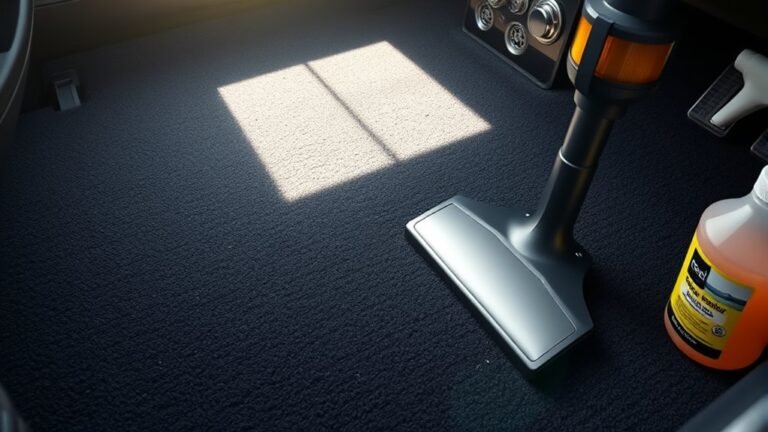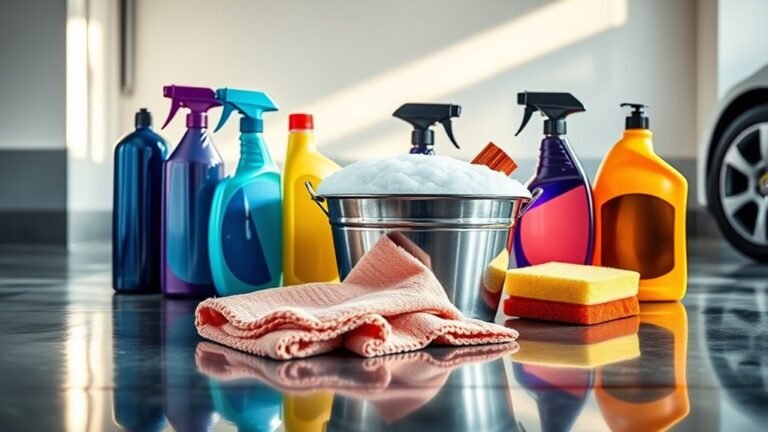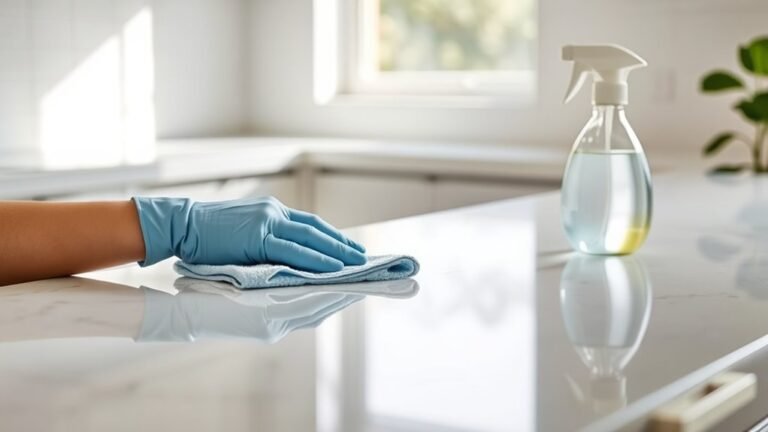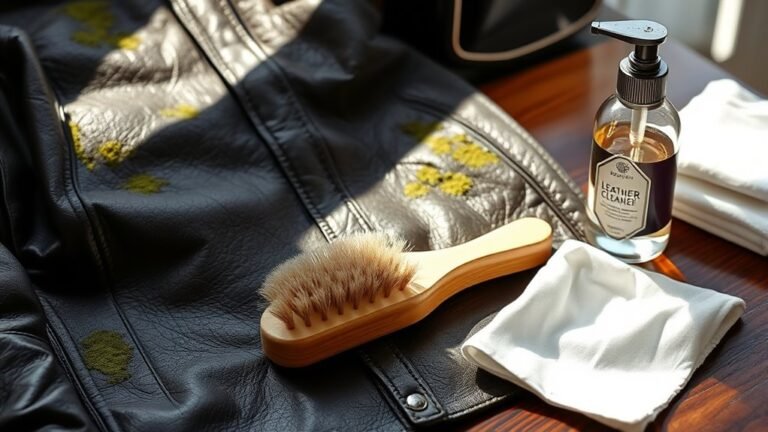How to Clean Car
To clean your car effectively, start by parking in the shade and removing any trash or loose dirt. Use eco-friendly soaps and soft sponges to wash from the top down, rinsing often to avoid scratches. Clean wheels with dedicated brushes and dry everything with microfiber cloths to prevent spots. Don’t forget the interior—vacuum thoroughly and wipe surfaces gently. Regular washing and protective wax keep your car looking fresh longer. There are also smart tips on seasonal care and prevention you’ll want to know.
Preparing Your Car for Cleaning
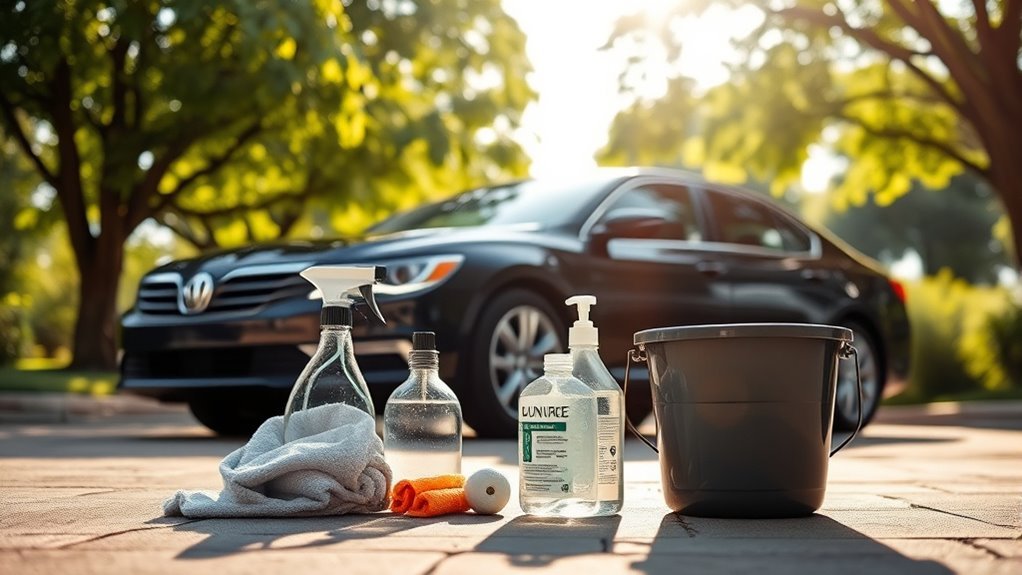
Before you start cleaning your car, make certain it’s parked in a shaded area to prevent soap and water from drying too quickly and leaving spots. Freedom means taking control, so use a pre cleaning checklist to make the process smooth and efficient. Begin by removing any trash, personal items, and loose debris from both inside and outside your vehicle. Next, check tire pressure and close all windows and doors tightly. These car preparation tips help you avoid distractions and guarantee every inch is ready for cleaning. By organizing your space and prepping your car properly, you’re setting yourself up for a satisfying, hands-on experience. Taking these simple steps lets you clean your car with confidence and enjoy the freedom that comes with a spotless ride.
Choosing the Right Cleaning Supplies
When you want to get the best results, using the right cleaning supplies makes all the difference. Choosing products that respect both your budget and the environment lets you clean freely without guilt or overspending. Here’s what you should focus on:
Using the right supplies balances effectiveness, budget, and eco-friendliness for guilt-free, affordable cleaning.
- Eco friendly options: Look for biodegradable soaps and natural cleaners that protect your car and the planet.
- Budget friendly supplies: Pick versatile items like microfiber cloths and multipurpose sprays that stretch your dollar.
- Quality tools: Invest in soft sponges and brushes that won’t scratch your paint but make cleaning easier.
Washing the Exterior Properly
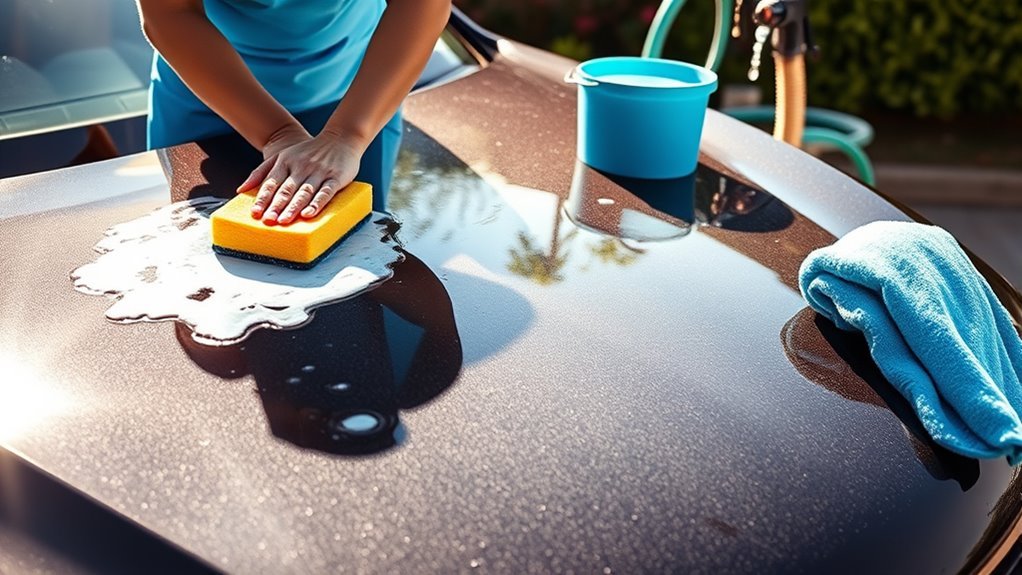
When washing your car’s exterior, picking the right soap is essential to protect the paint. You’ll want to use effective techniques that remove dirt without causing damage. Finally, drying your car carefully helps prevent scratches and water spots.
Choosing the Right Soap
Although it might seem like any soap will do, choosing the right one is essential for protecting your car’s paint and finish. You want a soap that cleans effectively without stripping wax or damaging clear coats. Here’s what to take into account when picking from various soap types:
- Car wash-specific soaps – Formulated to be gentle yet powerful, these preserve your vehicle’s finish.
- Eco friendly options – Look for biodegradable soaps that won’t harm the environment or your local waterways.
- pH-balanced formulas – These maintain the natural oils and protective layers on your car’s surface.
Choosing wisely lets you enjoy freedom from harsh chemicals and keeps your car looking its best longer.
Effective Washing Techniques
Even if you’ve chosen the perfect soap, how you wash your car makes all the difference in protecting its finish. Start by using spot cleaning techniques to tackle stubborn dirt or grime before giving your whole car a rinse. This approach lets you focus on problem areas without scrubbing the entire surface unnecessarily. When you’re ready for a full wash, pressure washing methods are a game-changer. They blast off dirt quickly without harsh scrubbing, preserving your paint’s integrity. Just keep the pressure moderate and the nozzle at a safe distance to avoid damage. By combining spot cleaning and gentle pressure washing, you can wash your car efficiently while maintaining its freedom to shine on every road.
Drying Without Scratches
After washing your car with care, the next step is drying it properly to prevent scratches and water spots. You want to keep that freedom to enjoy a spotless shine without damage. Here’s how you can do it:
- Use high-quality microfiber towels – they’re soft, absorbent, and minimize friction that causes scratches.
- Pat dry gently instead of rubbing; this avoids dragging dirt particles that can mar the paint.
- Consider waterless drying sprays for quick touch-ups or smaller spots, saving time while protecting the finish.
Cleaning the Wheels and Tires
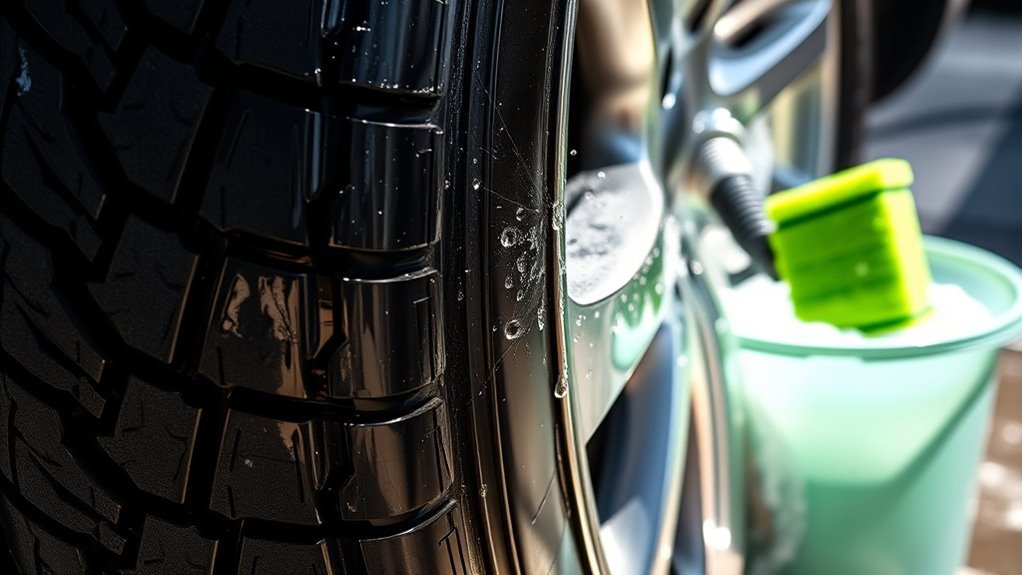
Start by focusing on the wheels and tires, since they often collect the most dirt and brake dust. Use wheel brushes to reach tight spots, scrubbing off grime without scratching. After cleaning, apply tire dressing to keep tires looking fresh and protected from cracking.
| Step | Tool/Material | Purpose |
|---|---|---|
| 1. Rinse | Water hose | Remove loose dirt |
| 2. Scrub | Wheel brushes | Clean brake dust and dirt |
| 3. Rinse again | Water hose | Wash off cleaner residue |
| 4. Dry | Microfiber cloth | Prevent water spots |
| 5. Dress | Tire dressing | Enhance tire appearance |
This approach lets you enjoy clean, sharp-looking wheels and tires without hassle or damage.
Drying and Polishing the Car’s Surface
While water spots can quickly ruin your car’s shine, drying it properly guarantees a flawless finish and prevents damage. To keep your ride looking fresh and free, mastering effective drying methods is key. After washing, avoid air drying; instead, use a microfiber towel or a soft chamois to absorb water gently and thoroughly.
Proper drying with microfiber or chamois prevents water spots and keeps your car’s shine flawless.
Once dry, it’s time to apply polishing techniques that enhance your car’s surface, restoring gloss and protecting the paint. Here’s how to nail it:
- Use a clean, soft applicator pad to apply polish evenly.
- Work in small sections with circular motions for best results.
- Buff with a microfiber cloth to reveal a brilliant shine.
These steps free you to enjoy a pristine, protected car surface every time.
Cleaning the Interior Effectively
Although cleaning the exterior gives your car a polished look, tackling the interior is just as important to maintain comfort and hygiene. Start by mastering vacuum techniques—focus on crevices and under seats to free your space from dust and crumbs. For upholstery care, use a fabric-safe cleaner or leather conditioner depending on your seats to keep them fresh and durable. Remember, a clean interior lets you enjoy your drive with freedom and ease.
| Task | Tip |
|---|---|
| Vacuum Techniques | Use attachments for tight spots |
| Upholstery Care | Test cleaners on hidden area |
| Dashboard Cleaning | Use microfiber cloth |
| Window Cleaning | Avoid streaks with newspaper |
| Floor Mats | Shake out and wash regularly |
Maintaining Your Car’s Cleanliness Regularly
To keep your car looking fresh, you’ll want to handle daily interior upkeep like wiping surfaces and removing trash. Sticking to a regular exterior washing routine helps prevent dirt buildup and protects the paint. Small, consistent efforts make a big difference in maintaining your car’s cleanliness over time.
Daily Interior Upkeep
Keeping your car’s interior clean every day doesn’t have to take much time, but it does require a bit of consistency. By sticking to simple habits, you’ll enjoy a fresh, clutter-free ride that supports your freedom on the road. Here’s how to stay on top of it:
- Use smart vacuuming techniques daily—focus on floor mats, under seats, and crevices to prevent dirt buildup.
- Organize items immediately; keep essentials like sunglasses, chargers, and documents in designated compartments or organizers.
- Wipe down surfaces quickly with a microfiber cloth to remove dust and spills before they set.
These small steps let you maintain a clean, inviting space effortlessly, so you’re always ready to hit the road without the hassle of deep cleaning every time.
Exterior Washing Routine
A regular exterior washing routine is key to preserving your car’s appearance and protecting its paint from damage. Sticking to exterior maintenance tips and adapting seasonal washing strategies lets you enjoy a spotless ride all year. During colder months, focus on removing road salt quickly, while summer calls for frequent rinsing to prevent buildup from dust and bugs. Here’s a simple guide to keep your wash routine effective and hassle-free:
| Season | Focus Area | Tip |
|---|---|---|
| Spring | Pollen & Debris | Use gentle soap, rinse well |
| Summer | Bugs & Dust | Wash often, avoid direct sun |
| Winter | Salt & Grime | Use warm water, dry thoroughly |
Preventing Dirt Buildup
Although regular washing is important, you’ll want to take steps that stop dirt from settling on your car in the first place. Preventive measures help keep your ride looking fresh and reduce the time spent scrubbing away grime. Dirt traps like mud flaps and rubber seals are your car’s first line of defense against buildup. To maintain your car’s cleanliness regularly, focus on these key actions:
- Use mud flaps to prevent dirt and stones from hitting your car’s sides and undercarriage.
- Inspect and clean dirt traps such as door jambs and wheel wells weekly to avoid accumulation.
- Apply a protective wax or sealant every few months to create a smooth surface that repels dirt and grime.
Stay proactive, and your car will stay cleaner longer, giving you more freedom to enjoy the open road.
Frequently Asked Questions
Can I Use Household Detergents Instead of Car-Specific Soaps?
You might think household detergent alternatives work fine, but they can actually strip your car’s protective wax and dull the paint. Car soap effectiveness comes from formulas designed to be gentle yet thorough, preserving your finish while cleaning. If you want the freedom to keep your ride looking sharp without damage, sticking to car-specific soaps is the smarter choice. They balance cleaning power with paint care better than typical household detergents.
How Often Should I Deep Clean My Engine Bay?
You should aim to deep clean your engine bay every 12 to 18 months, depending on your engine cleaning frequency preference and driving conditions. Sticking to a maintenance schedule helps prevent grime buildup and keeps your engine running smoothly. If you love freedom on the road, a clean engine bay means fewer surprises and better performance. Just don’t overdo it—too frequent cleaning might cause issues. Balance is key for hassle-free driving!
What Are the Best Techniques for Removing Pet Hair From Seats?
Imagine your car seats as a fluffy pet hair battlefield, where every strand stages a tiny rebellion. To reclaim your freedom, grab removal tools like rubber gloves, sticky lint rollers, or a vacuum with a brush attachment. Rub, roll, or suck those stubborn hairs off relentlessly. You’ll liberate your seats and breathe easy, knowing you’ve conquered the furry insurgents without surrendering to endless fluff warfare. Freedom feels cleaner, doesn’t it?
Is It Safe to Use a Pressure Washer on All Car Surfaces?
When it comes to pressure washer safety, you shouldn’t assume all car surfaces can handle the force. Some areas, like painted panels and delicate trims, might get damaged if the pressure’s too high. You’ve got to check surface compatibility before blasting away. Using a lower pressure setting and keeping a good distance lets you clean effectively without risking scratches or dents. So, be mindful and adjust your approach to protect your ride’s finish.
How Do I Prevent Water Spots in Hard Water Areas?
To prevent water spots in hard water areas, you’ll want to focus on water spot prevention tips like drying your car immediately after washing. Use a microfiber towel or a chamois to avoid streaks. Consider using filtered or distilled water when rinsing to reduce mineral deposits. You could also apply a quick detailer or water-repellent spray to protect the surface. These simple steps help keep your ride looking spotless and free from annoying water spots.


